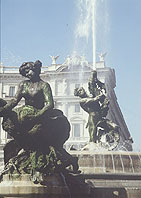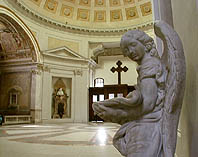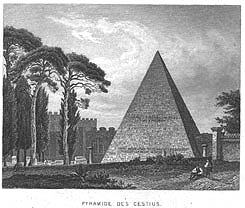Baths of Diocletian
 (Terme di Diocleziano) (1561, Vanvitelli). Almost a century after Caracalla gave Romans his gargantuan Baths, Emperor Diocletian, who never even visited Rome, strove to outshine his imperial predecessor by commissioning the largest and most gorgeous bathing establishment the world had ever seen.
(Terme di Diocleziano) (1561, Vanvitelli). Almost a century after Caracalla gave Romans his gargantuan Baths, Emperor Diocletian, who never even visited Rome, strove to outshine his imperial predecessor by commissioning the largest and most gorgeous bathing establishment the world had ever seen.
It could accommodate 3000 bathers simultaneously, about twice as many as the Baths of Caracalla, covered 13 hectares (32 acres) and had the full panoply of changing rooms, gymnasiums, libraries, meeting rooms, theaters, concert halls, sculpture gardens, vast basins for hot, lukewarm and cold plunges, as well as mosaic floors and marble facades. Today's luxurious spas and health resorts are but pale copies of the Baths of Diocletian.
Fragments of the Baths' core were incorporated into the Renaissance Church of Santa Maria degli Angeli and form part of the Museo Nazionale Romano.
But most of the ancient bathing complex is gone, either fallen down or pulled down. The curved colonnade of Piazza della Repubblica follows the outer wall of the former great exedra.
A few blocks away in either direction are two graceful rotundas marking the corners of the gardens, one of which is now the Baroque (1600) Church of San Bernardo alle Terme.
The Baths were built of brick that was faced on the inside with marble and on the outside with white stucco imitating blocks of white marble, like the Baths of Caracalla. The enormous central hall, 280 by 160 yards, is an engineering wonder that was the model for the Basilica of Maxentius in the Roman Forum.
When the Medici pope called in his chosen architect, Michelangelo, both of these aging Renaissance men wanted to honor the architectural wonders of the past by converting a monument of pagan hedonism into a religious masterpiece.
 The unprepossessing facade is a rounded brick wall, one of the interior partitions of Diocletian's ancient Bath.
The unprepossessing facade is a rounded brick wall, one of the interior partitions of Diocletian's ancient Bath.
Interior: The church's entrance originally separated the now-vanished hot "caldarium" baths from the luke-warm "tepidarium" of Diocletian’s Bath, which is now the church's vestibule.
Next comes the finest statue in the church, representing St. Bruno, founder of the Carthusian order, by the 18C French sculptor Jean-Antoine Houdon.
You then enter the ancient Bath's central hall.
The altar is straight ahead on the short axis of the nave, while the overwhelming bulk of the original baths runs in both directions toward the altars on either side, lavishly decorated by Vanvitelli.
The effect of this crossing at the center is breathtaking for its vast size and elegant proportions.
Italian state funerals are usually held here. During the Christmas and Easter seasons there are concerts of religious music.
298 AD. Emperor Maximian, on his return from Africa, began constructing a vast bathing establishment, acting on behalf of his co-Emperor Diocletian, who was reigning in Asia Minor. 300-305. Diocletian is considered responsible for the forced labor of 10,000 Christians in the back-bending task of construction. At about the time of completion, 305 AD, both emperors were forced to abdicate. 538. The Goths cut off Rome's water by demolishing the aqueducts, rendering Rome's 900 Baths useless. 1561. Pope Pius IV Medici commissioned the 86-year old Michelangelo to design a church honoring the angels and the Christian martyrs who died in the Baths' construction. 1749. Luigi Vanvitelli reconstructed the Church of Santa Maria degli Angeli. 1889. Museo Nazionale Romano was installed in a small part of the original Bath to house works of art from ancient Rome.![]() Our favorite: the curious "meridian" (1703), a sundial on the right side of the transept, which for a century and a half was used to determine midday for the city of Rome. Light comes in through a carefully placed opening high up on the wall and falls across a brass strip embedded in the floor, which is the exact North-South meridian of Rome. When the sunray lines up precisely along the strip, that's high noon.
Our favorite: the curious "meridian" (1703), a sundial on the right side of the transept, which for a century and a half was used to determine midday for the city of Rome. Light comes in through a carefully placed opening high up on the wall and falls across a brass strip embedded in the floor, which is the exact North-South meridian of Rome. When the sunray lines up precisely along the strip, that's high noon.
Baths of Diocletian
History
Basilica of St. Mark
(Basilica di San Marco, 336). Built on the ruins of a 1 C Christian oratory. The Persian Saints Sennen and Abdon, martyred near the Colosseum, repose in the crypt.
Under the altar are the remains of Pope St. Mark who founded this church.
The Byzantine mosaics over the apse are 9 C, the coffered ceiling is 15 C and the 20 columns veneered with Sicilian Jasper are 18 C. A palimpsest which was incorporated into the construction of Palazzo Venezia in the 15 C.
Catacombs of Priscilla
(Catacombe di Priscilla). As old as the Catacombs of San Callisto and Sant'Agnese, 2 C AD. Considered the most remarkable for its early frescoes, a 210 AD "Madonna with child", and 3C Old and New Testament scenes.
Via Salaria, 430. Tel. 06 86206272Fee.Guided tours. Open 8:30 am - noon, 2:30 pm to 5 pm. Closed Monday
(Beyond Map Area)
Pyramid of Caius Cestius
(Piramide di Caio Cestio) Sadly, of all the pyramids that dotted the Roman landscape then, two millenia later this is the only survivor.
 Pyramid of Caius Cestius Pyramid of Caius CestiusHistory 18-12 BC. The Ancient Romans had recently conquered Egypt, and the height of fashion was to have a pyramid for a tomb. Caius Cestius Epulo was praetor (chief magistrate), politician, and "Epulo", one of the state priests in charge of public religious banquets. His tomb has frescoes inside, but is closed. 3C AD. It was incorporated into the Aurelian walls of Rome. 1663. Restored under Pope Alexander VII Chigi. |
Piazzale Ostiense (Beyond Map Area)